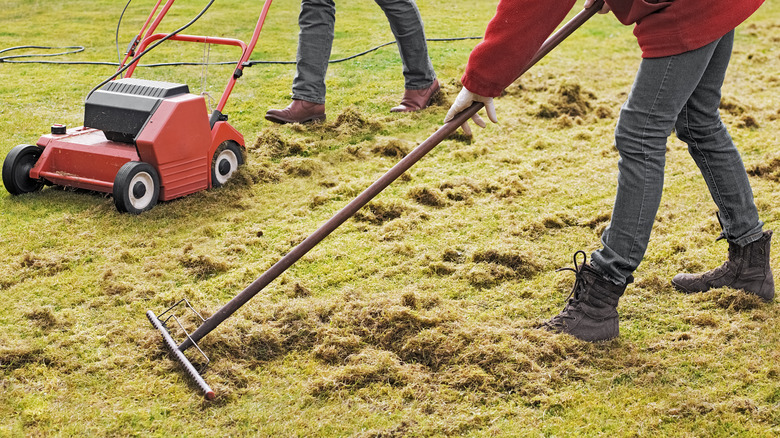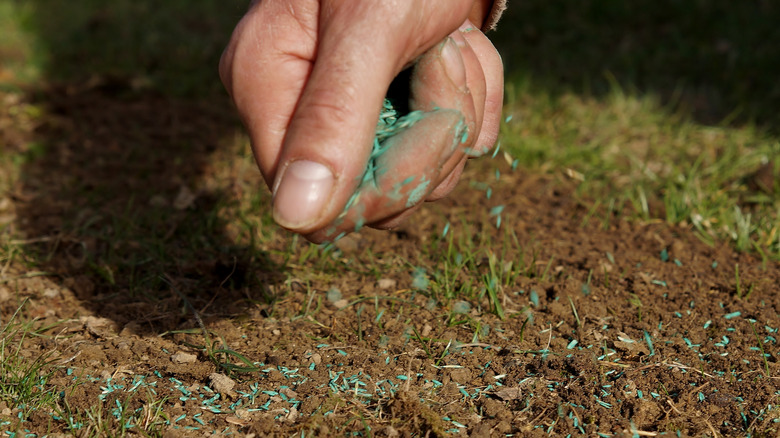Fall is the perfect time to overseed your lawn since the cooler temperatures are easier on the grass, and any added moisture will help seed germinate. Before you start overseeding, take a closer look at the grass to find a dead patch or dry spot. It’s important to fix these areas and not just try to add seed to them. Dry or dead patches develop for many reasons, often due to the poor condition of the soil or some type of contamination occurring in that particular area, especially if it’s quite localized.
Your goal is to determine what’s causing the dead spot, fix it with a few helpful instructions in our tutorial here, and then overseed for better results. Why does this matter? If you prep the soil now, remove the problem debris, seed it, and water it heavily in the fall, you’ll have better results for the spring. That’s because the healthy grass blades will continue to fill in those open spaces, minimizing the room for weeds to propagate themselves.
If you’re already raking your lawn at this time of the year to remove leaves (or will be in the next few months), now is the perfect time to follow these steps to fix those dead patches and ensure your spring lawn looks fantastic.
Fix the dry spots and damaged areas in a few steps

Dry areas typically lack nutrients, air, and moisture in the soil, and that leads to damaged, dry, and yellow grass. Sometimes, this also happens due to the grass becoming dormant, which means it slows down its growing process to conserve energy while there are fewer nutrients available to it.
To fix this type of problem, start by raking the grass in the problem area. You can use a traditional rake if you don’t have a thatching rake, but the stronger tines and unique angle of the thatch will do a better job of pulling up all of the dead debris and matted material that’s creating a barrier between the soil and the air, limiting moisture flow. Rake the entire dead spot, removing any material that comes up. This may make the lawn look worse in those areas for a short time, but it’s worth it.
The next step is to aerate the lawn, which is the process of creating access points in the grass to allow air and moisture to penetrate better. You can rent an aeration machine to do this work, running it back and forth over the problem area. Or, you can switch things up like ope.itsmowtime on TikTok does. Using a mechanical aerator and a few pogo stick-like moves to create holes in the grassy area. This creates the perfect surface for overseeding.
Overseed in just a few more steps

Before you move forward with the overseeding, give the grass a good drink, allowing the water from a sprinkler to run for several minutes in this targeted area. This is particularly important if conditions have been very dry in your area. Do this for a couple of days to super hydrate the area, aiming to do so during the early morning hours so there’s ample time for it to penetrate and evaporate. It’s a misconception to think that grass doesn’t need to be watered during the fall and cooler months of the year.
Finally, it’s time to overseed the lawn patches. Doing this in the fall will give the seedlings enough time to establish before the cold weather hits and the grass goes dormant. With your now-healthier soil, that’s going to be easier to do than it would have been in the summer’s hot sun. If the area is looking pretty bare after aerating and thatching, purchase a mulch-seed blend to help fill in the area, but don’t compact it so much into the holes that you’re limiting air flow again. Use a seed blend that’s appropriate for your area and one with a combination of grasses that do well. Avoid inferior products with high concentrations of weed seed in them.
Use a seed applicator to evenly cover the area. Don’t be afraid to go beyond the actual damaged patch into the surrounding areas to encourage it all to blend well. Keep the area moist, and next year, you’ll have a lawn to be proud of!